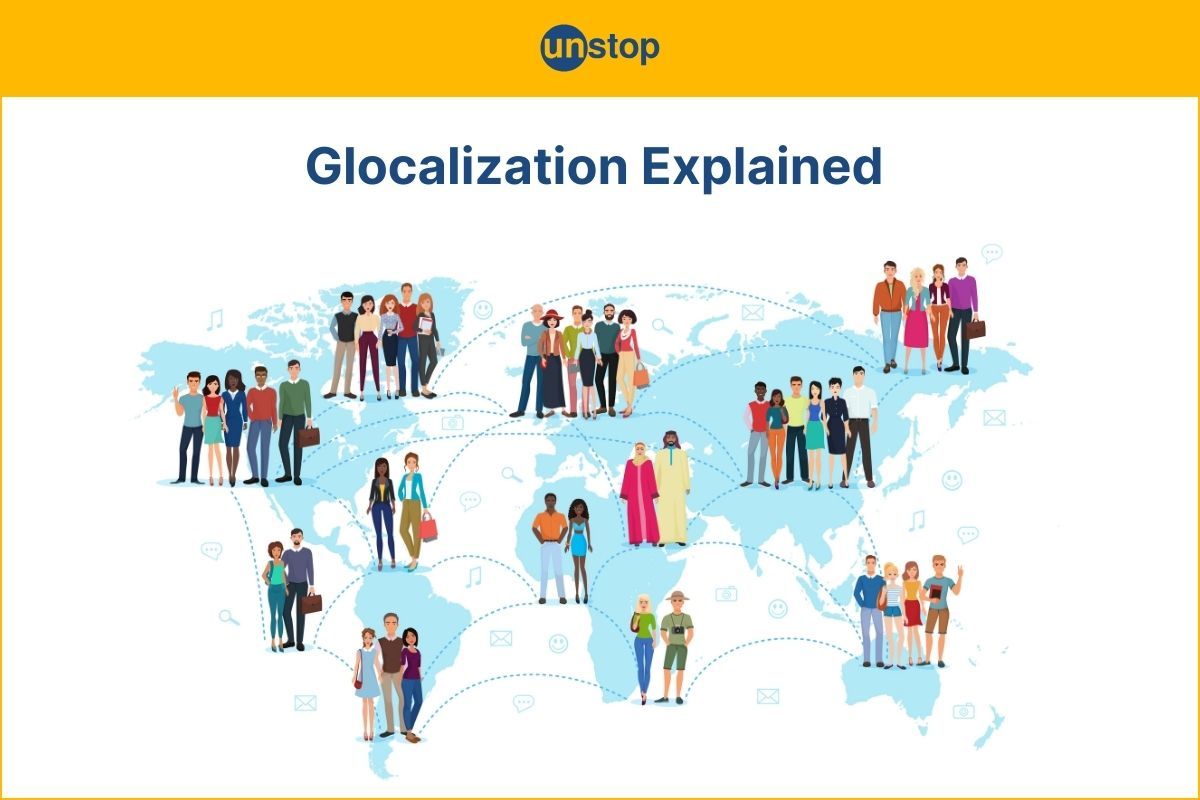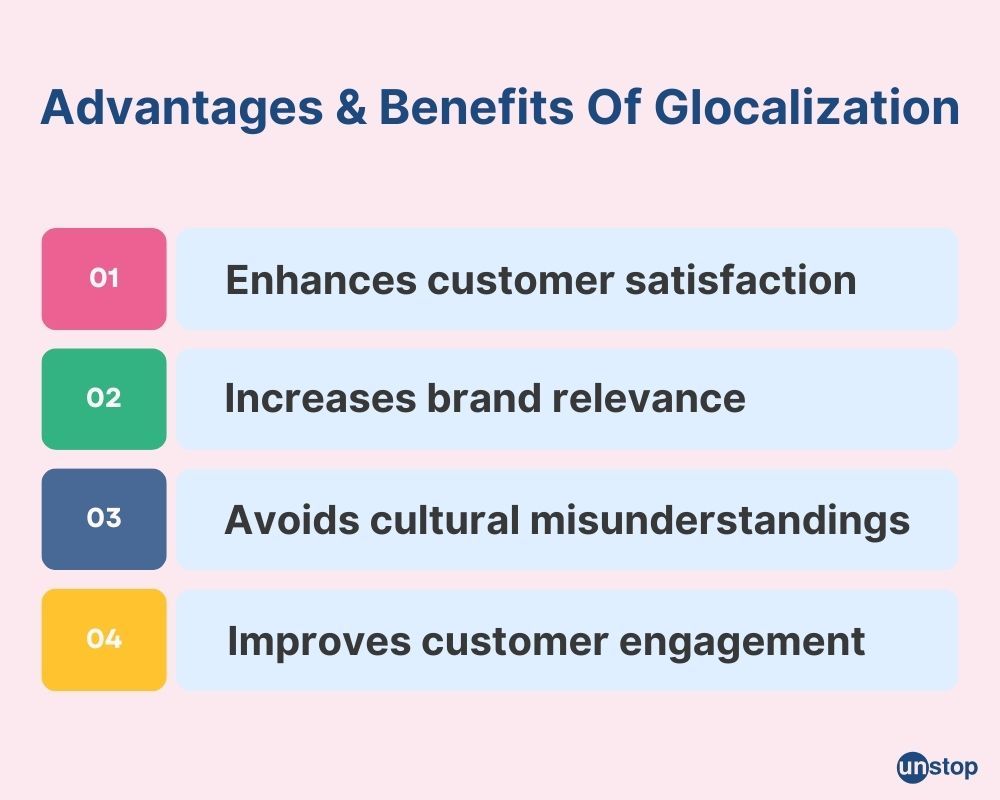- Difference Between Glocalization & Globalization
- Growth & Influence Of Glocalization
- Glocalization: Advantages & Benefits
- Walt Disney: Example Of Glocalization
- McDonald's: Example Of Glocalization
- Applying Glocalization To Your Company
- Frequently Asked Questions (FAQs)
What Is Glocalization? A Detailed Explanation With Examples

Glocalization, also known as glocalization or localization, is a strategic approach that involves adapting global products or services to meet the specific needs and preferences of local markets. It combines elements of both the global and local contexts to create a unique offering that resonates with customers on a deeper level. By embracing glocalization, businesses can effectively cater to diverse cultural backgrounds, ensuring their products or services align with the unique tastes and expectations of different regions. This not only enhances customer satisfaction but also strengthens brand loyalty and market penetration.
Difference Between Glocalization & Globalization
Globalization is the spread of products, ideas, and capital across international borders by corporations. Alongside words like globalization and internationalization, glocalization sounds like yet another mashup term made up by money-hungry marketers. However, the concept of glocalization merges these two terms that represent the amalgamation of something local and global.
Glocalization and globalization are two distinct concepts that have significant differences.
|
Glocalization |
Globalization |
|---|---|
|
Focuses on adapting global products and services to local markets |
Focuses on standardizing products and services across global markets |
|
Emphasizes the importance of understanding local cultures, customs, and preferences |
Emphasizes the integration and homogenization of cultures |
|
Involves tailoring marketing strategies and communication to specific local audiences |
Involves creating a unified marketing approach for a global audience |
|
Encourages localization of product features and functionalities |
Encourages standardization of product features and functionalities |
|
Allows for flexibility and customization to meet local market needs |
Promotes efficiency and economies of scale through a standardized approach |
|
This can result in higher costs due to the need for localization efforts |
This can result in lower costs due to economies of scale |
|
Requires a deep understanding of local markets and consumer behavior |
Requires a broad understanding of global markets and trends |
|
This can lead to greater customer satisfaction and loyalty |
This can lead to increased brand recognition and market share |
|
McDonald's is an example of adapting menus to local tastes and preferences |
Examples include Coca-Cola's consistent branding and product offerings worldwide |
Growth & Influence Of Glocalization
Glocalization, a term first coined by sociologist Roland Robertson in 1992, has become an important concept in today's globalized world. It emerged as a response to the challenges faced by multinational corporations in adapting their offerings to different cultures and countries. Let's delve into the history of glocalization and how it has shaped business strategies.
Early Adopters Of Glocalization
Multinational corporations were among the early adopters of glocal strategies. They recognized that simply replicating their products or services globally would not suffice due to differences in local culture, customs, and preferences. As a result, they started tailoring their offerings to cater to the unique needs and tastes of each region or country they operated.
Impact Of Digital Technology
The rise of digital technology has further accelerated the adoption of glocal practices. With increased connectivity and access to information, companies can now easily understand and engage with local populations on a deeper level. This enables them to create products and marketing campaigns that resonate with specific communities.
Overcoming Cultural Challenges
One of the main challenges faced by companies expanding globally is navigating through different cultures. Glocalization helps bridge this gap by allowing businesses to adapt their products or services according to local cultural nuances. For example, McDonald's offers menu items tailored to regional tastes, such as rice dishes in Asian countries or vegetarian options in India.
Localization Beyond Translation
Glocalization goes beyond mere translation of languages; it involves understanding the cultural context and incorporating it into business strategies. This includes considering factors like traditions, values, beliefs, and even community organizations within each region. By doing so, companies can establish stronger connections with local communities while avoiding potential pitfalls caused by cultural misunderstandings.
Homogenization Vs Diversity
While globalization often leads to homogenization where cultures become more similar, glocalization celebrates diversity. It recognizes the importance of preserving and promoting local cultures while still allowing for global expansion. This approach fosters cultural exchange and mutual understanding between different countries and regions.
Glocalization: Advantages & Benefits
Let's take a closer look at how glocalization can enhance customer satisfaction, increase brand relevance, mitigate cultural misunderstandings, and ultimately lead to improved sales and market share.

Enhances Customer Satisfaction
One of the key advantages of glocalization is its ability to tailor products or services according to local preferences. By understanding the unique needs and preferences of different markets, companies can customize their offerings to better align with local tastes, trends, and cultural nuances. This localization approach ensures that customers feel understood and catered to, resulting in higher levels of satisfaction.
Increases Brand Relevance
Glocalization allows brands to establish relevance within different cultures and markets by adapting their messaging, branding elements, and marketing strategies accordingly. By incorporating local insights into their campaigns, companies can create content that resonates deeply with target audiences. This approach not only helps brands connect with consumers on a personal level but also positions them as culturally aware and inclusive.
Avoids Cultural Misunderstandings
By embracing glocalization strategies, companies can avoid cultural misunderstandings or offensive content that could potentially harm their reputation. Adapting products or marketing materials based on local customs, traditions, values, and sensitivities ensures that messages are conveyed appropriately across different cultures. By taking the time to understand and respect local cultures, businesses can build trust and credibility among diverse audiences.
Improves Customer Engagement
Glocalized strategies often lead to increased sales and market share due to improved customer engagement. When customers feel that a brand understands their unique needs and preferences, they are more likely to develop a deeper connection and loyalty towards that brand. Social media campaigns localized for specific markets can generate higher levels of engagement, such as likes, comments, and shares. This heightened engagement not only drives immediate sales but also fosters long-term relationships with customers, resulting in repeat business and positive word-of-mouth recommendations. It motivates companies to constantly improve their brand image.
Walt Disney: Example Of Glocalization
The Walt Disney Company is a prime example of glocalization in action, as it incorporates cultural elements from various countries into its theme parks, movies, and merchandise. This approach allows Disney to appeal to a wide range of audiences globally while maintaining the essence of local cultures.
Incorporating Cultural Elements In Theme Parks
Disney's theme parks worldwide are renowned for their immersive experiences that transport visitors into different worlds. One way they achieve this is by incorporating cultural elements specific to each location. For instance, at Tokyo Disneyland, Japanese-themed attractions like "The Enchanted Tiki Room: Stitch Presents Aloha e Komo Mai!" and "Pooh's Hunny Hunt" cater specifically to the local audience.

Image credit: Freepik
By infusing these cultural elements, Disney ensures that visitors feel a sense of familiarity and connection with their surroundings.
Localized Versions Of Movies
Disney understands the importance of language and cultural nuances. To ensure wider global appeal, they create localized versions of their movies. This involves dubbing or subtitling films in different languages and adapting storylines to resonate with specific regions. For example, in the French version of "Beauty and the Beast," Belle has a distinct French accent, making her more relatable to French-speaking audiences. These adaptations not only enhance the viewing experience but also make Disney movies accessible and enjoyable for people around the world.
Customized Merchandise For Each Market
Disney merchandise is highly sought after by fans worldwide. To cater to diverse markets effectively, they customize their products based on regional preferences and demographics. For instance, characters popular among specific demographics or regions may be featured prominently on merchandise sold there. Limited-edition items exclusive to certain locations create a sense of exclusivity and encourage collectors from around the world to seek out these unique offerings.
Collaboration With Local Partners
To truly embrace glocalization, Disney collaborates with local partners to adapt their offerings to local tastes. A notable example is the Shanghai Disney Resort, where Disney worked closely with Chinese partners to integrate Chinese culture throughout the park. This collaboration resulted in attractions like "Garden of the Twelve Friends," which features Disney characters reimagined as Chinese zodiac animals. By partnering with locals, Disney ensures that its theme parks and experiences are not only entertaining but also resonate deeply with the local audience.
McDonald's: Example Of Glocalization
McDonald's, the global fast-food chain, is a prime example of glocalization in action. The company understands that food tastes and preferences vary across different countries and cultures, and it has successfully adapted its menus to cater to local palates.
Varying Menus For Regional Tastes
One way McDonald's embraces glocalization is by offering region-specific items on their menus. For instance, in India, where beef is not widely consumed due to cultural and religious reasons, McDonald's introduced the McSpicy Paneer burger made with a popular Indian cheese.

Image credit: Freepik
In Japan, they serve the Teriyaki McBurger to appeal to the local preference for teriyaki-flavored dishes. These adaptations allow McDonald's to connect with customers on a more personal level by providing familiar flavors.
Marketing Campaigns Tailored To Local Cultures
To resonate with diverse cultures around the world, McDonald's adapts its marketing campaigns accordingly. They understand that what works in one country may not be effective in another. By incorporating local customs, traditions, and holidays into their advertisements and promotions, they create a sense of relevance and familiarity for consumers. This approach helps build brand loyalty while also respecting cultural nuances.
Incorporating Local Design Elements
McDonald's takes inspiration from local architecture or cultural motifs. Each branch incorporates elements that reflect the unique identity of its location. From traditional Chinese-inspired structures in China to sleek modern designs in urban centers like New York City or Tokyo, these adaptations make customers feel at home while still enjoying the familiar experience of dining at a McDonald's.
Collaboration With Local Suppliers
To ensure that their ingredients align with regional preferences and quality standards, McDonald's collaborates with local suppliers wherever possible. By sourcing produce locally, they can offer fresh ingredients that meet customer expectations while supporting local economies. This approach not only enhances the glocalization efforts but also demonstrates McDonald's commitment to sustainability and community engagement.
Applying Glocalization To Your Company
In order to successfully apply the concept of glocalization to your company, you must tailor your offerings to meet the specific needs and preferences of different regions or countries. Mentioned below are some important points to consider:
Respect Local Customs, Values & Traditions
The Walt Disney Company has successfully applied glocalization by tailoring its offerings to fit the cultural preferences and sensitivities of different regions. For instance, when opening Disneyland in Tokyo, they incorporated elements of Japanese culture into the park design, such as traditional architecture and local cuisine. By respecting these customs and values, companies can establish a strong connection with their target audience.
Adapt Products Or Services To Cater To Market Demands While Maintaining Core Brand Identity
Glocalization involves adapting your products or services to meet the specific demands of each market while preserving your core brand identity. The Walt Disney Company exemplifies this practice by creating localized content for different regions. For example, they produce region-specific television shows like "Violetta" in Latin America and "Sofia the First" in Southeast Asia. By doing so, they ensure that their content resonates with local audiences while staying true to their overall brand image.
Collaborate With Local Partners For Effective Glocal Strategies
To implement successful glocal strategies, it is important for businesses to collaborate with local partners who possess knowledge about the target market. The Walt Disney Company has partnered with various local entities in different countries to navigate cultural nuances effectively. One notable collaboration is Shanghai Disney Resort, where Disney worked closely with Chinese partners to incorporate authentic Chinese elements into the park's design and attractions. This collaboration not only enhances the visitor experience but also strengthens relationships within the local community.
Continuously Gather Feedback From Customers & Adapt Offerings Accordingly
A key aspect of glocalization is continuously gathering feedback from customers and adjusting offerings accordingly. The Walt Disney Company understands this well and actively seeks input from guests through surveys, focus groups, and social media engagement.

Image credit: Freepik
This feedback allows them to identify areas for improvement and make necessary changes to ensure their offerings remain relevant and appealing to their target audience.
By applying the principles of glocalization, businesses can create a stronger connection with their customers in different markets. Understanding local customs, values, and traditions, adapting products or services to meet market demands while maintaining core brand identity, collaborating with local partners, and gathering continuous feedback are essential steps toward successful glocal strategies.
Conclusion
In today's global market, glocalization plays a pivotal role in the success of businesses. It is essential as it connects businesses with customers on a deeper level. By understanding and catering to local needs, companies can build trust and loyalty among consumers worldwide. Furthermore, glocalization helps organizations navigate cultural differences, language barriers, and regulatory requirements. This approach not only enhances customer satisfaction but also drives revenue growth by tapping into new markets. Apply these principles to your own business by conducting thorough market research, investing in localization efforts, and fostering cross-cultural collaboration within your organization.
Frequently Asked Questions (FAQs)
1. What are some potential challenges when implementing glocalization?
Implementing glocalization can come with its fair share of challenges. Some potential hurdles include language barriers and translation issues, understanding cultural nuances accurately, navigating legal regulations across different regions or countries, managing supply chain complexities for localized products/services, and balancing standardization with customization effectively.
2. How does glocalization impact consumer behavior?
Glocalization has a significant impact on consumer behavior as it addresses their specific needs and preferences within local contexts. When businesses adapt their offerings to suit local markets through glocalization strategies such as product localization or culturally sensitive marketing campaigns, consumers feel understood and valued. This connection fosters trust, loyalty, and a higher likelihood of purchase.
3. Can small businesses benefit from glocalization?
Absolutely! Glocalization is not limited to large corporations. Small businesses can also leverage this strategy to expand their reach and connect with diverse customer bases. By understanding the local market's unique characteristics and tailoring their products, services, or marketing efforts accordingly, small businesses can gain a competitive edge and establish themselves as trusted brands within specific regions.
4. How does glocalization contribute to innovation?
Glocalization encourages innovation by pushing companies to think creatively about how they can adapt their offerings to different markets. This process often leads to the development of new products, services, or business models that cater specifically to local needs. By embracing glocalization, companies foster an environment of continuous improvement and stay ahead in an ever-evolving global marketplace.
5. What role does cultural intelligence play in glocalization?
Cultural intelligence is vital in successful glocalization efforts. It involves having an in-depth understanding of various cultures, values, customs, and preferences. Cultural intelligence allows businesses to navigate cultural differences sensitively, avoid miscommunication or offense, and tailor their offerings effectively for different markets. Developing cultural intelligence within your organization through training programs or hiring employees with diverse backgrounds can greatly enhance your glocalization strategies.
Suggested reads:
- Experience Curve: An Effective Guide For Strategic Success
- J-Curve: Usages & Effects On Economics And Private Equity
- Deflation Vs Disinflation: Understanding The Key Differences
- Electronic Money: All You Need To Know & Be Secured Using It
- Economies Of Scope: Definition, Benefits, Strategies & Examples
Instinctively, I fall for nature, music, humor, reading, writing, listening, traveling, observing, learning, unlearning, friendship, exercise, etc., all these from the cradle to the grave- that's ME! It's my irrefutable belief in the uniqueness of all. I'll vehemently defend your right to be your best while I expect the same from you!
Login to continue reading
And access exclusive content, personalized recommendations, and career-boosting opportunities.
Subscribe
to our newsletter
















Comments
Add comment